“Why did the scarecrow get the job?
Because he was outstanding in his field!”
This is a popular recruiting joke, yet finding the best talent is not easy. 67% recruiters say that their biggest challenge in hiring is the lack of high-quality and skilled candidates. The global talent shortage is at its highest in 12 years, and companies are finding it challenging to fill open positions with suitable candidates. The top 3 skills that companies work the hardest to fill are cloud and distributed computing, statistical analysis, and data mining, and middleware and integration software.
Recruitment may be a function of a company’s in-house HR or it may be subcontracted through a Recruitment Processing Outsourced (RPO) company. An RPO may act as an internal recruiting function of a company, or replace it.
Some of the world’s best organizations have developed their own ways to identify the cream of the crop, and it is worth emulating. Matching new hires to company culture is tricky, thus hiring practices can make a lot of difference. Find out how do top MNC hire its candidates?
The Traditional Approach to Hiring
Before e-recruitment and social media recruitment came into play, traditionally organizations would follow a fairly simple, but long and often inefficient process of hiring. It included the following general steps—resume screen, phone screen, in-person interview cycles, sample work test (sales pitch or technical), and a “culture-fit” interview which depended on the interviewer’s “gut feeling.
Dr. Anna B. Holm (2012) visualized the traditional recruitment process as part of her research on e-recruitment. She divided the process into four tasks:
- Identify applicants
- Attract applicants
- Process incoming applications
- Communicate with applicants
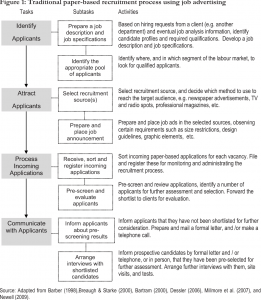
Source: Semantic Scholar
-
Identifying applicants
Hiring needs are identified on the basis of HR plots, and strategies for long- and short-term hiring are developed.
Next, job description and job specifications are created, and the appropriate pool of candidates is identified. This is done by reviewing the elements of the job role and the essential skills required to perform it.
To determine job specifications and expectations, the individual interview, and group interview methods are used, wherein individuals or a group of individuals who have a similar role have a discussion with HR. When the role does not currently exist, the technical conference method is used wherein subject matter experts are engaged to provide inputs to HR about the main job duties.
The first stage forms the base of the recruitment process.
-
Attracting applicants
A job announcement is prepared to attract potential candidates suitable for the role. The recruitment source and the advertisement depend on the industry and the position of the recruiting organization. Traditional recruitment sources are trade journals, newspaper advertisements, and TV and radio advertisements.
-
Processing incoming applicants
The hiring manager and the recruiter work together to receive, sort, pre-screen, and evaluate applicants. After pre-screening, candidates are shortlisted for interview.
-
Communicating with applicants
Poor communication skills (of the recruiter) could cause him/her to lose valuable applicants. They must be informed of the status of their application at every step. Interestingly, 76% of respondents in an iCIMS Inc. survey said that not getting any updates after applying was more frustrating than being ghosted after a first date.
External Recruitment
External recruitment looks for candidates outside one’s organization. Traditionally, this has been done through advertising in local newspapers, by word of mouth, by signs outside businesses, or by using employment agencies. These agencies could be headhunters, temporary agencies, or consulting agencies.
Job fairs have always been a powerful way to boost employer branding and attract suitable candidates.
Campus recruitment in universities and other educational institutions is a good way to find candidates for jobs that require a certain minimum educational qualification.
Internal Recruitment
Internal recruitment involves promoting talent already present within one’s organization. This is brought about in two ways:
- By internal job postings on the company’s internal job boards
- By career ladders
Internal recruitment is advantageous because the candidate’s culture fitment and performance is already known and hiring costs are reduced. Also, external recruits are paid more than internal promotions because they need to feel confident about accepting a job at an organization, especially if they are making major life changes for the role.
Local Hiring
Local hiring involves hiring people who live close to their workplace. It sends a signal to customers and clients that the company is invested in the growth of the area in which it is located and the health of the local economy. The company may be eligible for financial incentives. It is easier to verify local candidates—there is no substitute for a face-to-face interview—and new hires tend to bring other suitable people into the company.
How does Top MNC hire candidates?
Nowadays, steps like candidate search, screening, and interview scheduling are becoming automated. Digital technologies are increasingly transforming talent procurement. Termed “e-recruitment,” this phenomenon involves the attracting, selection, and application processing of candidates via the Internet.
Increased candidate expectations and the shortage of suitable talent is forcing recruiters to experiment with new methods of hiring.
We take a closer look at some innovative techniques used by top MNC :
Tech-driven interviews
A LinkedIn survey found that 58% of respondents believed that new interviewing tools would influence recruiting and hiring significantly. Online assessment tools that incorporate video technology, such as those provided by Talscale, provide a comprehensive overview of a candidate’s skills and fitment.
Citi, Deutsche Bank, Reebok, and Airbnb use Koru’s pre-screening online assessments to get a sense of a candidate’s soft skills. Koru has decreased the number of bad hires by as much as 60%.
Hyatt, Unilever, and Accenture use Pymetrics, which challenges candidates with “games” to measure around 90% cognitive and emotional traits. This has led to a 20% increase in the diversity of the hires and a 65% increase in retention rates.
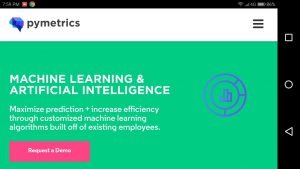
Source: YouTube
Lloyds Banking Group is using virtual reality (VR) to engage employees in simulated 3D environments to evaluate their skills. A good level of scoring differentiation is achieved, which indicates that VR can effectively differentiate between different levels of capability.
Aegis Worldwide uses chatbots to conduct initial interviews via text messaging because the medium has been shown to have a 45% response rate (as opposed to a 6% email response rate). Johnson & Johnson uses the text recruiting app Text.io to reduce gender bias and improve response rates.
Data- and AI-driven talent acquisition
Vodafone and Intuit use chatbots to streamline their recruitment process. Chatbots help recruiters save 67% of their time, 30% of their costs, and removes human bias by 43%.
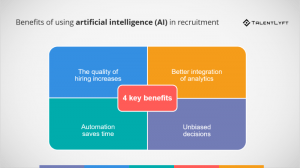
Source: TalentLyft
Nielsen, Jetblue, and Novartis are using data analytics in their recruitment process to understand patterns in advance and make strategic hiring decisions.
Unilever has adopted an AI-driven candidate sorting and assessment approach for its campus hiring program. Instead of a resume, a candidate’s LinkedIn profile is used to choose the best prospects via AI. There is anecdotal evidence that the quality of hires using the AI-driven process at least match the quality of hires using the traditional process.
Candidate Conversion via Talent Relationship Management (TRM)
Talent relationship management focuses on talent, rather than just candidates, and aims to build a network of workers to identify and engage with potential talent. Hiring managers who use TRM tools have observed an offer acceptance rate of 93% against the market average of 89%.
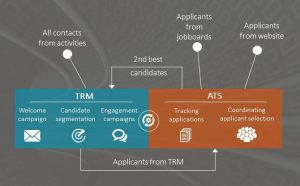
Source: IntraWorlds
Hiring through Social Media Platforms and Apps
LinkedIn, Twitter, and Facebook are not the only social media platforms that recruiters use to engage with talent. McDonald’s is using Snapchat to invite applications, called “Snaplications.” McDonald’s Australia received four times the number of applications through Snapchat within 24 hours than it did via traditional methods in a week.
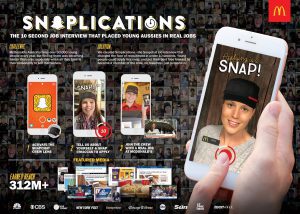
Source: WPP
Goldman Sachs is using Spotify, a music streaming app, to run banner ads and audio messages to attract young talent. The bank has used Snapchat earlier.
Thus, the differentiation between traditional hiring methods and innovating hiring techniques is summarized:
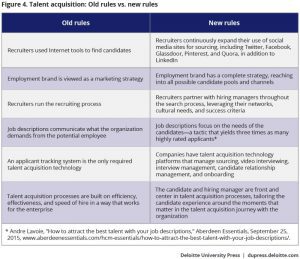
Source: Deloitte Insights
Case Study: How Citi uses Predictive Analytics to Hire “Millennials”
Company profile:
Citigroup Inc., an American multinational investment bank and financial services corporation, is headquartered in New York City.
Challenges:
The banking industry is under pressure to cut costs, and find and retain top talent. Citi wanted to use artificial intelligence to predict which employees will succeed at a given job by creating patterns based on large amounts of data. It already uses social media to attract potentially young talent.
Although 91% employers feel that soft skills are important to the future of recruiting and HR, it is very challenging to screen for soft skills.
Solution:
Citi is exploring predictive analytics with a Seattle startup Koru to help it hire graduates. In a pilot program, graduates applying to its US corporate and investment bank in 2018 will have to take the Koru assessment.
Founded in 2013, Koru uses machine learning and behavioral profiling to predict whether a candidate is right for a company.
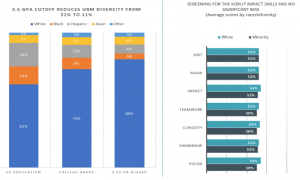
Source: Koru
Koru has developed a pre-screening online assessment called Koru7 Impact Skills, which scores for seven key skills: impact, rigor, curiosity, teamwork, polish, grit, and ownership. The 20-minute, user-friendly test tells employers how well a candidate fits the ideal profile.
Questions cover three main areas:
- Past experience – extracurricular activities and jobs that demonstrate skills
- Work scenarios – how candidates respond to various scenarios
- Workstyle – personal preferences about values and approaches
Candidates get instant feedback on their top soft skills, which makes for a fun candidate experience, without giving them access to their complete data. The rankings are generated by machine learning algorithms that compare candidates’ scores with those of top-performing employees.
Outcomes:
- Enabled Citi to see a broader, more diverse talent pipeline
- Provided a holistic picture of candidates and enabled Citi to have informed and meaningful discussions with candidates about predetermined areas of weakness and strengths
Since Koru is at a pilot stage, concrete data is not yet available.
Case Study: How Hilton Cut Time-to-Hire by 90% using Pre-Hire Assessments
Company profile:
Hilton Worldwide Holdings Inc. is an American multinational hospitality company that manages a wide portfolio of hotels and resorts. It is headquartered in Tysons Corner, Virginia. It aims to be the most hospitable company in the world.
Challenges:
Hilton’s recruiting team was finding it challenging to keep up with the rapid growth of its portfolio brands and the company’s global expansion.
Solution:
The Hilton Reservations and Customer Care (HRCC) team began to use HireVue’s video interviewing capabilities and data science to transform its high-volume recruiting model.
Previously, Hilton was using a traditional assessment with more than 100 questions which took over an hour to complete. Thus, it had low completion rates and the company needed 6 weeks to get 25 new hires.
Hilton reduced its multi-step assessment process into a single video assessment. The video interviewing platform used predictive analytics to evaluate a candidate’s vocabulary, nonverbal gestures, and intonation.
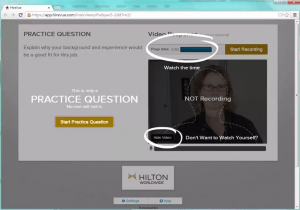
Source: LinkedIn
Outcomes:
- 94% candidate satisfaction rate; Net Promoter Score of 84.9—2X that of Hospitality Industry
- Time-to-hire reduced from 42 days to 5 days
- Assessment completion rates were doubled
- Recruiter workload was reduced
- 40% improvement in interview hire rates
Case Study: How Unilever Reduced Time-to Hire by 90% using Interview Assessment Technology
Company profile:
Unilever is a British-Dutch multinational consumer goods company, which owns more than 400 brands. It is one of the oldest multinational companies in the world and is headquartered in London and Rotterdam.
Challenges:
Unilever realized that it needed to attract talent from around the world, especially millennials, to keep up with the fast-changing and dynamic consumer needs. Previously, it required 4-6 months to select 800 candidates from 250,000 applications. It was using traditional methods such as phone screening and manual assessments.
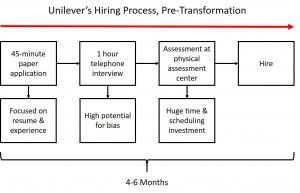
Source: HireVue
Solution:
The company used HireVue for mobile-optimized, recorded video interviewing and video assessment technology. The AI-driven algorithm filtered up to 80% of the candidate pool to select candidates most likely to be successful at Unilever based on factors like word choice, body language, and facial expressions.
At every step of the process, candidates received and gave feedback, even if they were not finally hired.
Outcomes:
- 80% positive candidate feedback; savings of 50,000 hours of candidate time
- Annual cost savings of more than £1 M
- 96% candidate completion rate (as compared to 50% previously)
- 90% reduction in time-to-hire
- 16% increase in diversity of new hires
About Talscale
A popular alternative video assessment platform is Talscale, which offers a suite of products to identify the best developer candidate by testing them on work sample assessments that mirror the environment at the workplace.





